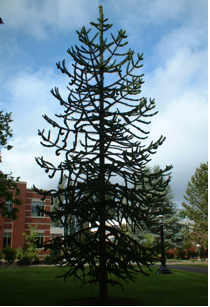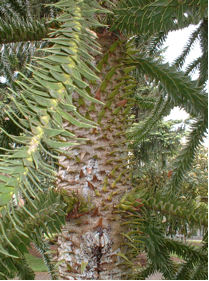The Monkeypuzzle
 |
 |
Tag Number: 383
Scientific Name: Araucaria araucana
The Arauco Indians of Chile are remembered in the word araucana.
Common Names
- Monkeypuzzle
- Pehuén
- Piño araucaria
- Piñonero
Habitat
Grows naturally in Southern Chile and Southwest Argentina; common ornamental in cool temperate zones such as Europe, North America, and Northern Asia.
Morphology
Branches grow in whorls of 5. Pineapple-like scales are present on branches, leaves, and trunk. It grows up to 164' tall and 7'4" in girth.
Phenology
Fruits around its 25th year and flowers once over 40 years old.
History
Thought to be the most ancient conifer present on the planet, these living fossils are identical to Monkeypuzzle trees fossilized 160 million years ago. Restored maps of Chile show that in 1550, Monkeypuzzle forests dominated the country. Unfortunately, intense logging of the trees and harsh fires instigated the formation of 4 reserves to protect this, the national tree of Chile. Its logging was prohibited when it was deemed a Chilean Natural Monument in 1976. In 1987, the title was stripped from the tree, but conservationists pushed for the reinstatement of the title, and it was granted in 1990. Currently Chile's government is under pressure from landowners to allow the logging of the tree despite its vulnerable status. Although the substantial bark of the species helped them survive volcanic lava, 74,000 acres of the protected forests were devastated by fires between 2001 and 2002. Some of the ravaged trees were above 2000 years of age. To further the tree's protection, the Convention on International Trade in Endangered Species of Wild Fauna and Flora prohibited its trade internationally in 2002.
Ethnobotany
Pine nuts (piñones) from the tree are the main carbohydrate source for the 60,000 Mapuche (earth people), who live in the southern Andes. The Pehuénche (monkey-puzzle-tree people), one of the Mapuche tribes, collect the seeds which compose 10-15% of their diet for 8 months of the year. The Monkeypuzzle stands decorated in the altar during Nguillatun (strong prayer), a two-day ceremony of the harvest that is held to offer thanks for the previous year's plentiful blessings and prayers for more in the upcoming year.


